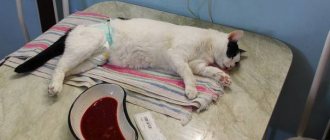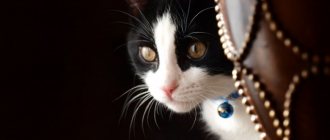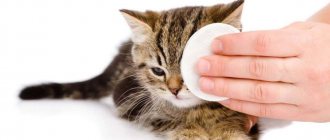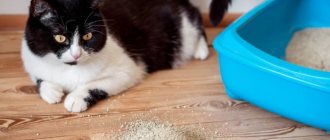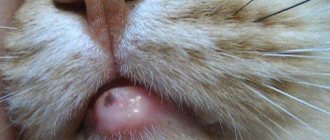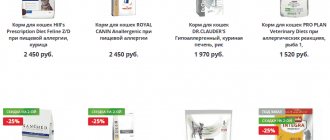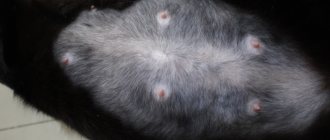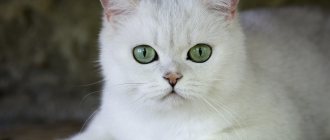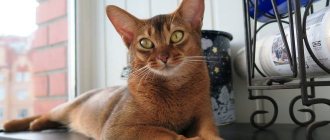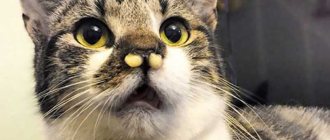12538Administration
1
The situation when a cat does not go to the toilet for a long time is quite common. There can be many reasons for such a deviation - from the most harmless to the very serious. Owners should remember that a healthy cat defecates approximately once every 1-2 days. In older animals, the period between bowel movements can stretch up to three days, but small kittens usually poop several times a day.
The frequency of trips to the toilet largely depends on the characteristics of the pet’s diet. However, if 3 or more days or even a whole week have passed since the last visit to the tray, you should be wary. Constipation may indicate serious health problems. It is imperative to find out the cause of the deviation and help the cat.
© shutterstock
Why doesn't the kitten go to the toilet?
Let's try to figure out why a little kitten doesn't go to the toilet. There are several reasons why a kitten may not go to bed:
- Firstly, it is stress due to a change in environment. As soon as he finds himself in a new home, he does not go to the litter box for the first 2-3 days. And this is normal, but if there is no stool for about 5 days, then the baby needs help.
- Another reason is the inexperience of the mother cat. As you know, in the first month of a baby’s life, feces are released only thanks to the efforts of the cat. If, due to inexperience or for other reasons, she refuses to massage the kitten’s tummy, then he accordingly cannot go big.
- An early transition to natural nutrition can negatively affect the health of the baby’s digestive system. Ideally, it would be if the kitten switched to full nutrition gradually, while still feeding on the milk of the mother cat.
- Congenital intestinal pathology does not allow the kitten to defecate calmly; in this case, urgent veterinary intervention cannot be avoided.
How to help a cat yourself
Fortunately, much more often a cat does not go to the litter box for a long time for reasons not related to illness. What to do in this case? How to help an animal? It all depends on the situation. Sometimes you just have to wait. For example, if the cat “forgot” about the litter box due to severe stress. As soon as the frightened animal “crawls out from under the sofa” and comes to its senses, the “toilet” problem will be solved by itself.
The same applies to the postpartum period in cats. Here you can try to speed up recovery by offering your pet liquid meals. If the reason for the long absence of bowel movements is sexual arousal, you can also just wait it out, or you can help the animal by giving him libido-reducing pills or finding a “mate.” The last option will work, but not for long. The best solution and guarantee of getting rid of pain is sterilization.
If there is a suspicion of hair accumulation in the gastrointestinal tract, cats are given a little Vaseline oil. Of course, the animal is unlikely to eat it of its own free will. However, you need to try to pour a small amount of the product into its mouth, holding it with your hands so that the pet swallows the oil. Literally a day later, the pet will feel the urge to defecate and visit the litter box.
If a cat does not go to the toilet for 5 days, and no serious health problems have been identified, then constipation is a situational phenomenon. It can cause serious damage to the body, so you should not pull it. It is allowed to give the cat a laxative such as Duphalac or do a cleansing enema.
© shutterstock
It is advisable to consult a doctor regarding both the first and the second. Most often, the cause of constipation is errors in the diet. What and how to feed your cat so that it goes to the toilet normally is described below.
In what cases should you consult a veterinarian?
Sometimes in kittens the development of bowel and bladder emptying is accompanied by disturbances. Deviations from the norm can be a symptom of serious problems with the internal organs of a small four-legged pet. You can recognize them in time by:
- constant monitoring of the baby’s behavior during defecation and urination;
- assessing the consistency, color and odor of urine and excrement;
- analysis of the frequency of bladder and bowel movements.
Doesn't walk small
So, if a cat goes to the toilet “little by little” less than 2 times a day, the process is accompanied by pain, screaming or bleeding, then something is clearly wrong with the cat’s body. Let's take a closer look at this pathology.
Reasons for violating the regime
There are several reasons why the process of emptying the bladder may be disrupted:
- Dehydration. Insufficient fluid intake or increased loss of moisture from the body can lead to hypovolemia. Hypovolemia may be caused by blood loss. In this case, less blood is filtered by the kidneys and less urine is produced.
- Obstruction of the urinary tract (urolithiasis). In this condition, urine is formed normally, but due to obstruction it cannot be released.
- Inflammatory kidney diseases, renal failure. Damage to the glomeruli can also lead to oliguria and even anuria (complete absence of urine).
- Poor nutrition. Excessive consumption of salty foods can also lead to fluid retention in the body.
Something else interesting: Baldness or hair loss in cats
Signs of difficulty
It is not difficult for an attentive owner to identify pathology. The pet rarely goes to the toilet, and even if it does, very little urine is released. While emptying its bladder, your cat may scream or moan, which is a sign that urination is painful. In addition, sometimes blood can be detected in the tray. Often the condition is accompanied by intoxication syndrome, as toxic substances accumulate that are normally excreted by the kidneys.
Help your pet
In order to help your pet, you need to determine the cause of the illness. Most often, this cannot be done at home. Therefore, if you notice signs of urinary retention, you should contact your veterinarian. He will prescribe an additional examination (general and biochemical blood tests, ultrasound), which will help determine the diagnosis. After this, appropriate treatment is prescribed.
If you understand that the cause is most likely dehydration, then you need to restore your hydration. To do this, give your cat liquid often, but in small portions.
In other cases, specific treatment is necessary. For inflammatory diseases, antibiotics are prescribed, and sometimes it is necessary to use infusion therapy and diuretics. In case of obstruction, catheterization of the bladder is performed, since an overfilled bladder can rupture.
Why doesn't an adult animal go to the toilet in a big way?
To help their pet, the owner must know what factors lead to the fact that the cat does not go to the toilet in a big way. The most common reasons leading to problems with bowel movements:
- Improperly balanced diet. When a cat eats food with a low protein and fiber content, he experiences stool retention, which is also observed when he abuses bones and drinks a small amount of liquid.
- A long-haired cat does not go to the toilet due to the presence of hair in the gastrointestinal tract, which enters the pet's stomach in considerable quantities as a result of the desire for cleanliness. Simply put, hairs that get inside are connected in the form of lumps and create great obstacles both for bowel movements and for the formation of feces.
- Stressful situations can arise not only in a kitten that has just been weaned from its mother cat, but also in an adult animal as a result of an encounter with a dog, a trip on public transport, or the arrival of noisy guests with small children.
- In old age, deterioration of the gastrointestinal tract occurs. The intestines cannot work in the same mode and do a poor job of pushing feces through their departments.
- Neutered cats tend to be obese, they are lazier, prefer to lie down more and are hungry all the time. These factors lead to obesity, which negatively affects the process of bowel movements.
- Diseases of the internal organs can make it difficult to pass stool.
Causes
Constipation in cats can be either an independent disease or accompany other pathologies. Depending on the age of the animal, they go to the toilet in different ways. An adult cat needs to go once every 24 hours, but a month-old kitten needs 3-6 times a day. Pregnant cats may not have a bowel movement for several days immediately before giving birth. This is considered normal, so they instinctively cleanse the body. The absence of a tray for up to 3-4 days indicates a problem.
Causes of constipation in a small kitten:
- congenital malformations of the gastrointestinal tract (most often problems with the anus);
- a sharp transition from milk to “adult” food;
- adaptation of the animal to new conditions;
- inflammatory processes.
An adult cat does not go to the toilet very often due to:
- improper diet and quality of nutrition;
- moving or changing home environment;
- trichobezoar - hairballs that are formed as a result of cleansing the fur with the tongue;
- obesity associated with castration;
- side effect from drugs;
- inflammatory diseases;
- compression of the intestines (multiple pregnancy, tumor, hernia, etc.);
- old age (feces have difficulty passing through the intestines, which have lost regulation due to age-related changes);
- Uncleaned or unfilled tray.
The prognosis is more favorable if the pet does not have large bowel movements. Lack of urination indicates more severe illness.
Changing your diet
A sudden change from one diet to another can lead to digestive upset in a kitten - this can be expressed either by diarrhea or constipation. Therefore, in the first week after purchase, it is advisable to feed the pet in the same way as the breeder did. Good breeders usually pay a lot of attention to this issue and often give new owners a supply of food for several days. Often, owners try to feed the kitten home-cooked food, but it all ends with the kitten eating only boiled or even raw meat and boiled eggs, and such a diet not only does not meet the nutritional needs of the kitten’s growing body, but also leads to constipation.
How can you solve a pet’s delicate problem at home?
When a cat cannot go to bed, she needs to consult a veterinarian, but if it is impossible to organize a trip to the clinic, then you can try using home remedies:
- First, you need to pay attention to what your pet eats. You need to include vegetables, kefir, and milk in your diet.
- You can add 5 drops of Vaseline oil to your cat's food. It is completely harmless to health and has a softening effect. Vaseline oil should not be replaced with vegetable oil, as the latter has a negative effect on the pet’s liver.
- As a last resort, you can give the cat a laxative, for example, Duphalac, Lactusan.
- Sometimes you can relieve your cat's condition with an enema. Doing an enema at home is not recommended. Frequent use of these measures is also prohibited, as they can lead to weakening of the intestinal muscles and the formation of chronic constipation.
- Experienced cat breeders recommend that if the cat does not walk for several days, include condensed milk in the food, dissolved in running water, in a ratio of 3 parts water to 3 parts condensed milk. You need to drink 1 tablespoon per hour. You should not give it more than 5 times a day, as the high sugar content has a detrimental effect on the pet’s body. Condensed milk dissolved in water will loosen the tummy and make bowel movements easier.
- A small kitten can be helped by massaging the tummy, which is performed by gently moving it around the clock cage with a cotton pad dipped in warm water.
- Preparations that help normalize the intestinal microflora, for example, bifidumbacterin or lactobacterin, are good for eliminating problems with stool.
Treatment of constipation in a cat
There are several methods for treating cats at home, but they should only be used after consulting a veterinarian. First you need to determine the exact cause and eliminate it. If the cause of constipation is an infection, then appropriate medications are prescribed. If the presence of parasites is suspected, deworming should be carried out. In case of intestinal obstruction and adhesions, surgery is indicated.
Diet
It will take more than one day to carry out treatment at home. First of all, it is important to choose food for cats with constipation. The menu should be changed by introducing fiber (vegetables, wheat, milk) into the animal’s diet. Such products help soften and better remove feces from the body. But this also has its drawbacks, since the cat begins to develop increased gas production. Due to the accumulation of gases in the intestines, its functions are disrupted and the animal suffers from pain.
To alleviate your pet's condition, you can add 2 drops of sunflower oil to your pet's food. This is enough for the animal’s stool to normalize and become softer. But this method is not entirely good for the functioning of the liver, so you should not get too carried away with adding oil, and for sick and old cats it is better not to use this method at all.
Laxatives
Often, pet owners do not know what laxative to give to their cat. To recover from antibiotics if there was a need to take them, and to maintain favorable microflora, it is a good idea to give the animal, for example, Duphalac. But first you need to consult a specialist who will prescribe the exact dosage, checking whether there are any contraindications to taking the medicine. For neoplasms, foreign bodies and adhesions, laxatives should be taken with caution.
Enema
It is not advisable to give an enema to a cat with constipation yourself, because without the necessary experience, there is a risk of causing pain to the animal and even injuring the intestines. There is also a risk of incorrectly calculating the amount of fluid administered or its temperature for a cat during constipation. Therefore, it is better to entrust this procedure to a specialist at a veterinary clinic.
Vaseline oil for constipation in cats
Many people consider this oil to be the best remedy for constipation. The substance has a beneficial effect on the intestinal walls and softens dry feces. But how much petroleum jelly to give a cat can only be calculated by a specialist based on the individual parameters of the animal. In most cases, the dose is administered 3-4 times a day and is approximately 5 ml. But combining the substance with other oils is strictly prohibited, otherwise the load on the liver will be too great.
Every pet owner should know how to administer the remedy and then monitor the cat's subsequent behavior. The algorithm of actions is as follows:
- Remove the needle from the disposable syringe, draw out the required dose of oil and slowly pour it into the mouth behind the cheek. In most cases, animals normally perceive this procedure, since the oil is odorless and tasteless.
- If after 3 hours the cat has not had a bowel movement, then after an hour you should repeat the procedure by adding 1 more dose of oil.
The animal should go to the tray within the next 1-2 hours. Sometimes emptying can be delayed for up to 6-17 hours. All this time it is important to monitor your pet.
Possible problems with urination and defecation in kittens
A small kitten must be properly cared for so that it can develop and grow normally. If he is separated from his mother and finds himself in the house of a new owner, then the adaptation period may be accompanied by stress. A number of negative factors can affect the weakening of an animal’s immunity. This affects the functioning of all body systems. Absence or problems with urination and bowel movements during this period are quite acceptable.
When the kitten has grown up and settled down, has become the owner of an excellent appetite, but does not go to the toilet properly, it is worth wondering if everything is okay with him.
Constipation in a kitten
The following disorders can cause constipation in kittens:
- Stressful state. Stress can be triggered by a variety of factors. For example, a visit to the veterinarian, the presence of other animals in the house. However, the most common is a change of residence. The kitten may not have a bowel movement for two to three days. Then everything returns to normal.
- The cat was separated too early. During this period, when the kitten misses its mother's closeness, the absence of stool may last for 4–5 days. If after this period the situation does not change, then you should seek help from a specialist.
- Wrong diet. If the baby ate natural food before he got to his new home, then you cannot suddenly switch him to dry food. Constipation in a kitten can be caused by too much protein in the diet.
- Worms. Intestinal parasites can cause intestinal blockages. This is a dangerous condition that requires medical attention.
If your baby cannot have a bowel movement for more than five days, he needs help. There are a number of recommendations:
- Microclyster. The procedure is allowed if there are no contraindications, that is, if constipation was caused by an unbalanced diet, and not by a violation of the digestive system.
- Enzyme preparations. Prebiotics can be given to a kitten only after prior consultation with a specialist. Mild laxatives prescribed by a veterinarian may also help (medicines for humans are not suitable).
Enzyme preparations must be prescribed by a veterinarian
- Oils. You can add a few drops of oil to your baby's food. Vaseline is the best option, since it cannot be absorbed into the gastrointestinal tract and does not overload the animal’s liver.
I recently learned about Vaseline oil for cats, but have already tried it. You only need a little bit of it, it’s completely unnoticeable with the kitten’s food. But it helps him go to the toilet, like a mild laxative. But others are not recommended to replace it. The same olive oil is absorbed into the gastrointestinal tract and adversely affects the liver.
Sometimes, as a proven old-fashioned method, it is recommended to use baby soap (a small piece is inserted into the kitten’s anus to irritate the walls of the rectum), but it is still recommended to choose more humane ways to help the pet (the same condensed milk will help less painfully).
Frequent stool
When a kitten suffers from diarrhea, this is a sign of a serious malnutrition problem. This situation will require urgent measures and treatment. The entire course of therapy must be carried out under the supervision of a veterinarian.
The most common reason is a change in diet. If the kitten does not receive its usual food, diarrhea occurs. It is necessary to return to your previous diet as quickly as possible.
Changing a kitten’s diet should not be abrupt; it is carried out according to a certain scheme.
There are other reasons for frequent bowel movements in kittens:
- Binge eating. Food that comes in large volumes cannot be digested normally and enters the intestines in liquid form. It is important to control kittens' portions according to their age.
- The food is not suitable or bad. You cannot feed your kitten pickled, fried, salted, or expired foods. This food is not suitable not only for kittens, but also for adult cats. It is not absorbed and causes diarrhea. Also, cats are not given food from the owner’s table (primarily because it contains salt, sugar or spices); food for animals must be prepared separately.
- Allergies or intolerances. Often kittens cannot digest or assimilate fatty fish, beef, and corn. It happens that some elements cause an allergic reaction.
- Poisoning. This phenomenon can be caused not only by food, but also by various substances. A kitten, due to its curiosity, can fit anywhere. Therefore, household chemicals and other chemical elements should be stored out of reach. If the baby is poisoned, then vomiting and lethargy will be added to the diarrhea. Only a specialist can help here.
- Parasites. The first and obvious sign of a kitten being infected with worms is diarrhea with mucus. Only medications can help here. If the case is advanced, then the help of a veterinarian is needed.
- Diseases. The cause of diarrhea can be infectious lesions in the body of a small pet.
Determining the causes of diarrhea
To get rid of the problem of frequent bowel movements, you need to find out its cause. To do this, you need to conduct a stool analysis. Factors of color, consistency, and impurities play a role here:
- Stool with a yellow tint will indicate that the kitten has been poisoned by some kind of food.
- If the feces have an admixture of blood or mucus, then this speaks in favor of helminthic infestation.
- Brown diarrhea indicates an allergic reaction.
- If the stool has a green tint and a persistent unpleasant odor, then the kitten has been poisoned by chemicals.
How to help a kitten with diarrhea
If loose stools have become a one-time occurrence, and the kitten feels normal, that is, he is alert and does not have a fever, then you can simply give the baby plenty of water and put him on a diet. The food restriction should continue for several days until everything returns to normal. In addition, you can give your pet a quarter of a tablet of activated carbon. If diarrhea is prolonged, accompanied by a deterioration in general condition, then an urgent visit to a doctor is necessary. He will be able to diagnose the cause and prescribe treatment.
Video: kitten has diarrhea - what to do
Urination in kittens: normal and abnormalities
In order to determine how often a kitten pees, you need to track how often it drinks water. The amount of fluid you drink should correspond to the amount of urine. An older kitten will empty its bladder up to 5 times a day. The process does not cause discomfort to the baby. Urine should be clean and transparent without any admixtures of blood or mucus.
No urination
If a kitten pees little or does not pee at all, there may be a number of reasons for this:
- suffered stress;
- diseases of the urinary tract;
- kidney disease;
- small amount of fluid consumed;
- exhaustion.
Also, the kitten may not visit the litter box if it is dirty, he does not like the litter, etc.
Many cats are very picky about the cleanliness of the litter box and the contents in it.
If the baby does not pee for a long time, and the owner notices weakness and apathy, lack of appetite, irritability, then you should urgently contact a veterinarian to establish a diagnosis and begin timely treatment.
No matter how many cats and kittens appeared in my house, during the first 24 hours no one peed or pooped. When entering a new home, any animal experiences stress. We understand that he will feel good here, no one will offend him. The cat is not sure about this yet. Therefore, she has no time to relieve herself. She should investigate everything and calm down.
Frequent urination
One of the reasons for frequent urination is the common cold. It can occur due to a draft or lying on a cold surface for a long time. A cold provokes the occurrence of cystitis - inflammation of the mucous membrane of the bladder, as a result of which its contractility is impaired. Cats, like humans, experience frequent urges to urinate, but the amount of urine may be small. the pet also experiences pain when urinating, which can be manifested by meowing.
Frequent urination can also result from:
- impaired metabolism;
- insufficient protein content in the diet.
You should not miss the moment when the kitten becomes a teenager and begins puberty. At this time, he may begin to mark his territory, so he pees more often.
Video: Frequent urination in cats
Rare urination
If the kitten pees rarely or does not pee at all, then this may indicate:
- congenital injury or congenital defect of the urinary system;
- atony of the bladder (weak contractility);
- injury or rupture of the bladder;
- spinal cord injury;
- development of tumors in the genitourinary system.
Anuria (absence of urination for more than a day) leads to dehydration, which can cause death in a kitten. Therefore, any suspicion of urinary problems should be a reason to consult a veterinarian.
Typically, diseases are accompanied by additional symptoms that are difficult to miss.
Lack of urine due to moving to a new place is quite acceptable, but the animal requires monitoring. If you do not urinate for more than 1.5 days, consult your doctor.
What to do?
Sometimes diseases whose symptom is constipation can be accompanied by other diseases.
Treatment of a disease whose symptom is constipation can only be prescribed by a doctor. Carrying out examinations on your own at home is problematic and not always effective. But you shouldn’t panic because your pet is unwell either.
What should the owner do first:
- Analyze the cat’s nutrition and behavior over the last 2-3 days. Constipation may have been caused by overeating or eating unwanted foods.
- Feel the stomach. Do not press too hard. Pay attention to the animal’s reaction: does palpation cause pain.
- Give more water, stop feeding.
- If constipation occurs after surgery, go to the hospital without delay.
After analysis and determination of the severity of the symptom, it is prohibited to give any medications. Only a veterinarian can make a final diagnosis, as well as prescribe additional examinations (x-rays, ultrasound examinations, urine tests).
Helping adult cats
Adults may be prescribed enemas with the addition of oil and take laxatives. Directions, purposes, and the name of the drug are prescribed by the veterinarian. Unauthorized use is dangerous for the health and life of the cat and can provoke a worsening of the condition.
Help kittens
If a problem stool is detected in a kitten, its diet, quality of drink and food are analyzed.
If a problem stool is detected in a kitten, its diet is analyzed
The maximum assistance that the owner can provide during a pre-medical examination:
- light massage of the kitten's belly;
- starvation diet;
- drinking plenty of fluids.
If the kitten’s condition worsens or stool does not normalize, urgently seek help from a veterinary clinic.
Important! Do not attempt to treat an animal without the appropriate instructions from a doctor with dosage forms intended for an adult or child.
Enema appointment
Significant results are achieved by using an enema. The method is simple, but it is better not to use it without some practice. The first time is done by a veterinarian.
How to give an enema to a cat with constipation
For the procedure you will need a syringe without a needle and Vaseline oil, chamomile, water. Chamomile decoction can be replaced with saline solution.
Be sure to read:
How to remove the smell of cat urine from shoes - special means: how to remove and what to do
How to perform an enema:
- Prepare chamomile decoction or saline solution at the rate of 1 tsp. chamomile or salt per 1 glass of water.
- Give cats a small amount of Vaseline oil 1-1.5 hours before the enema.
- Lubricate the tip of the syringe (the place where the needle is connected) with Vaseline and sunflower oil. Gently insert into the anus. If you have a syringe, the insertion depth should not exceed 1.5-2 cm.
- Pinch the anus with your tail. Keep the animal in your arms in this state for a quarter of an hour.
What to do at home if your cat is constipated?
Significant results are achieved by using an enema.
Douching as a method gives a positive result. But cats don’t like it, as they experience pain during the enema.
Also, frequent use of a syringe as an aid has the opposite effect: the intestines stop functioning normally, and in 75% of cases the procedure provokes the appearance of ulcers.
It is strictly forbidden to use douching if:
- pregnant cat;
- the animal suffers from cardiovascular diseases;
- blood clots and bleeding were noticed;
- there are violations of the integrity of the skin in the genital area.
Important! It is dangerous to resort to self-treatment if frequent constipation occurs.
Dietary recommendations for a constipated cat
In the question of what to do when a pet does not walk for several days, a therapeutic diet can help, which includes the following diet:
- Soups, cereals, soaked dry food.
- It is best to mix boiled vegetables with the animal’s food, because it is rare for a cat to eat vegetables separately. Zucchini, beets, and pumpkin are good for these purposes.
- Fermented milk products help normalize the digestion process and combat stool problems.
- Raw liver or fish are rarely recommended for your pet.
You should not give a cat suffering from stool retention chicken, chicken broth, rice, eggs, or boiled meat. If a cat eats these foods, he often experiences defecation problems. For cats that do not go to the toilet for several days, specialized food is recommended, which is best selected from a veterinarian.
When a kitten does not go to the toilet for more than 6 days, it is better to find out from the previous owners what the baby eats and give him this food. After 3-4 days, you can gradually add new ingredients, for example, finely chopped meat, it contains proteins and can help solve the problem of feces.
Symptoms
The most important sign is that the cat does not go to the toilet in a big way. Usually, owners do not immediately notice this, and when they realize that their pet is sick, they wait for several days with the hope that it will recover. 3-4 days without a litter box can kill a cat.
He can behave very restlessly, meow loudly, scratch, fuss, but it is much worse if the pet is lethargic and drowsy. The abdomen may be swollen, hard, and painful when you try to touch it.
When a cat tries to use the litter box, it may leave behind traces of blood or other impurities, such as pus. At the beginning of the disease, animals usually try to attract attention to themselves by any means, but after a few days, on the contrary, they hide in secluded places where they are difficult to find.
What to do if there are deviations
Violation of the frequency of toilet visits by a small kitten is usually associated with stressful situations. Such factors disappear by themselves when the animal goes through an adaptation period. The situation is more complicated when urination is impaired due to health problems. In this case, the kitten can either walk too often or too rarely.
If a kitten pees frequently, then most likely he has developed cystitis, a disease of the urinary organs, or urolithiasis. The baby will often run up to the tray, but the volume of urine will be catastrophically small. Sometimes there is blood in the urine.
Frequent urges can be caused by drinking too much in hot weather, as well as diabetes. Urinary incontinence is accompanied by a large amount of fluid released and no bleeding. The same signs are characteristic of marking territory.
Cystitis most often occurs in adult kittens. The reasons may be:
- drafts;
- sand in the kidneys;
- impaired metabolism;
- mineral imbalance;
- sexual infections;
- predominance of dry food, lack of liquid and proteins.
Deviations from the norm should be studied and treated in veterinary clinics.
Urolithiasis can affect cats at any age. Signs of the disease are:
- unsuccessful visit to the tray;
- a tiny amount of urine;
- presence of blood in the urine;
- vomiting and high fever;
- lethargy and apathy.
There are cat breeds that are genetically predisposed to this disease. Among them are Scottish Fold, Persian and Siamese breeds.
Also, frequent urination can be associated with diabetes, stress or enuresis. In any case, assistance to the pet must be qualified and timely. If there is the slightest sign of a pathological condition, you should immediately contact a veterinarian. He will prescribe a number of diagnostic measures and adequate treatment.
A kitten who pees frequently will undergo the following tests:
- blood biochemistry;
- Analysis of urine;
- X-ray;
- comparison of the amount of urine and drink;
- Ultrasound;
- hormone test;
- determination of acetone levels and acid-base balance.
These types of studies will help to identify the nature of the disease of the genitourinary system, make a diagnosis and decide on treatment.
In addition to adequate therapy, it is important to carry out a number of preventive measures for the full functioning of the genitourinary system. Regular medical examinations, proper diet, physical activity, and the optimal amount of drinking will ensure normal urination and healthy urinary tract of the kitten.
Rare urination is just as dangerous to a kitten's health as frequent urination. In such situations, the main cause is pathological processes, both in the genitourinary system and in the body as a whole. Almost 75% of cases of insufficient urine flow or insufficient discharge occur due to cystitis. Lack of proper treatment will invariably lead to a condition such as acute urinary retention.
Having such a diagnosis, a kitten may not walk for more than a day. This is a dangerous phenomenon that often ends in death. The bladder becomes full and bursts. Urine enters the abdominal cavity, which can lead to intoxication of the body and death of the pet.
Kittens need to be fed crushed food.
The pathology most often occurs in male kittens. For females, such a disease is not typical, although it is also sometimes detected. The main cause of the disease is stones that block the urinary tract. Experts identify other factors:
- blockage of the urethra by a blood or mucus clot. Occurs against the background of trauma to the genital organ or an infectious disease, in particular the bladder;
- abnormal kidney function. With renal dysfunction, the kitten’s body can no longer excrete urine even in minimal volumes. The cause may be a malignant tumor or perforation of the kidney;
- spinal injury or infectious disease affecting the spinal cord. The absence of a nervous connection between the genitourinary organs and the spinal cord leads to disruption of their functioning and the cessation of urination of the animal.
Urinary retention of any stage requires urgent treatment. In the clinic, a kitten may be prescribed the following procedures:
- catheterization using a special catheter that is inserted into the urethra. This will help empty your bladder;
- surgical intervention. Prescribed in case of ineffectiveness of repeated catheterization.
We suggest you familiarize yourself with: Rules for caring for a Maine Coon, features of keeping: how to feed a Maine Coon so that it grows big
To prevent advanced cases of impaired urination, the owner of kittens must take preventive measures daily:
- animals must receive anti-infective vaccinations on a schedule;
- avoid hypothermia;
- provide access to an unlimited amount of fresh and clean water;
- the diet must comply with the kitten’s nutritional rules according to its age;
- an active lifestyle and outdoor games will also be beneficial.
For any pathological conditions or deviations from the norm, it is prohibited to prescribe medications yourself. Kittens must be treated by a veterinarian. He will also tell you how many times a kitten should poop and pee per day. This will keep your little pet healthy and alive.
Deviation from the norm in the number of visits to the tray requires mandatory consultation with a veterinarian. It is important to quickly determine the cause of the problem in order to prescribe treatment.
Be sure to read:
Causes and treatment of constipation in cats, how to help a cat go to the toilet in a big way
A number of diseases can be successfully treated at the beginning of their development, but in an advanced form they can most likely lead to the death of the pet.
Prevention
In most cases, constipation in cats can be prevented by following veterinarian recommendations:
- do not feed your pets bones;
- comb the fur more often and give special pastes for prevention to remove it from the intestines;
- introduce bran and fermented milk products into the diet of animals;
- carry out deworming in a timely manner;
- make sure that the cat always has access to clean water, she should drink a lot;
- reduce the likelihood of stressful situations;
- increase physical activity - buy the cat a lot of toys, play with him more often.
If your cat does not go to the toilet for several days and the problem continues, consult a veterinarian. The animal must be examined for neoplasms in the digestive organs and other pathologies. Remember - difficulty or absence of bowel movements can lead to intestinal blockage, severe intoxication and even death of your pet.
Prevention of lack of stool in cats
To prevent cats from having defecation retention, preventive measures must be taken. Firstly, you need to review the animal’s diet and pay attention to what the pet eats during the day. You should not feed your pet from the table. A cat who eats food of excellent quality does not suffer from stool retention. When the owner gives him natural food, he needs to create a diet that contains meat and vegetables. If a cat eats steamed bran, it has a good effect on the functioning of the digestive system.
Cats are fairly clean creatures who always willingly take care of their fur. To prevent your cat from swallowing it, you need to do regular brushing. Pet stores also have products that help remove hairballs from the gastrointestinal tract.
As a rule, neutered cats tend to have a recumbent lifestyle. The less the pet moves during the day, the worse it goes to the toilet. When an animal is given balls, toys, climbing machines, and taken for a walk, then, as a rule, he does not have problems with peristalsis.
Treatment at the Bio-Vet veterinary clinic
What to do with a cat if he doesn't go to the toilet? Only a veterinarian can decide correctly. If your pet does not feel better after taking Vaseline oil, bring him to our Bio-Vet clinic.
Our highly qualified specialists will help your pets at any stage of the disease. The main thing is, do not delay and do not try to treat the poor animal with folk remedies or advice from the Internet - entrust the life and health of the cat to professionals!
Prices for appointments in our network of veterinary clinics
| Name of veterinary services | Unit | Price, rub |
| ⭐ Initial appointment | 1 animal | 400 |
| ⭐ Repeated appointment | 1 animal | 200 |
| Primary reception of ornamental, exotic animals, birds and reptiles | 1 animal | 1000 |
| Consultation without an animal | — | 500 |
| Consultation with a doctor based on test results | 1 PC. | 400 |
